Impact of COVID-19 on Fashion Industry
VerifiedAdded on 2022/12/23
|11
|2898
|95
AI Summary
This report discusses the impact of the COVID-19 pandemic on the fashion industry, including the challenges faced and opportunities for adaptation. It focuses on Next Plc, an international clothing retailer, and explores the effects on manufacturing, distribution channels, sales, and events. The report also includes analyses of Porter's 5 Forces, PESTLE factors, and SWOT analysis. It concludes with a discussion on how companies can adapt to the changing business environment.
Contribute Materials
Your contribution can guide someone’s learning journey. Share your
documents today.
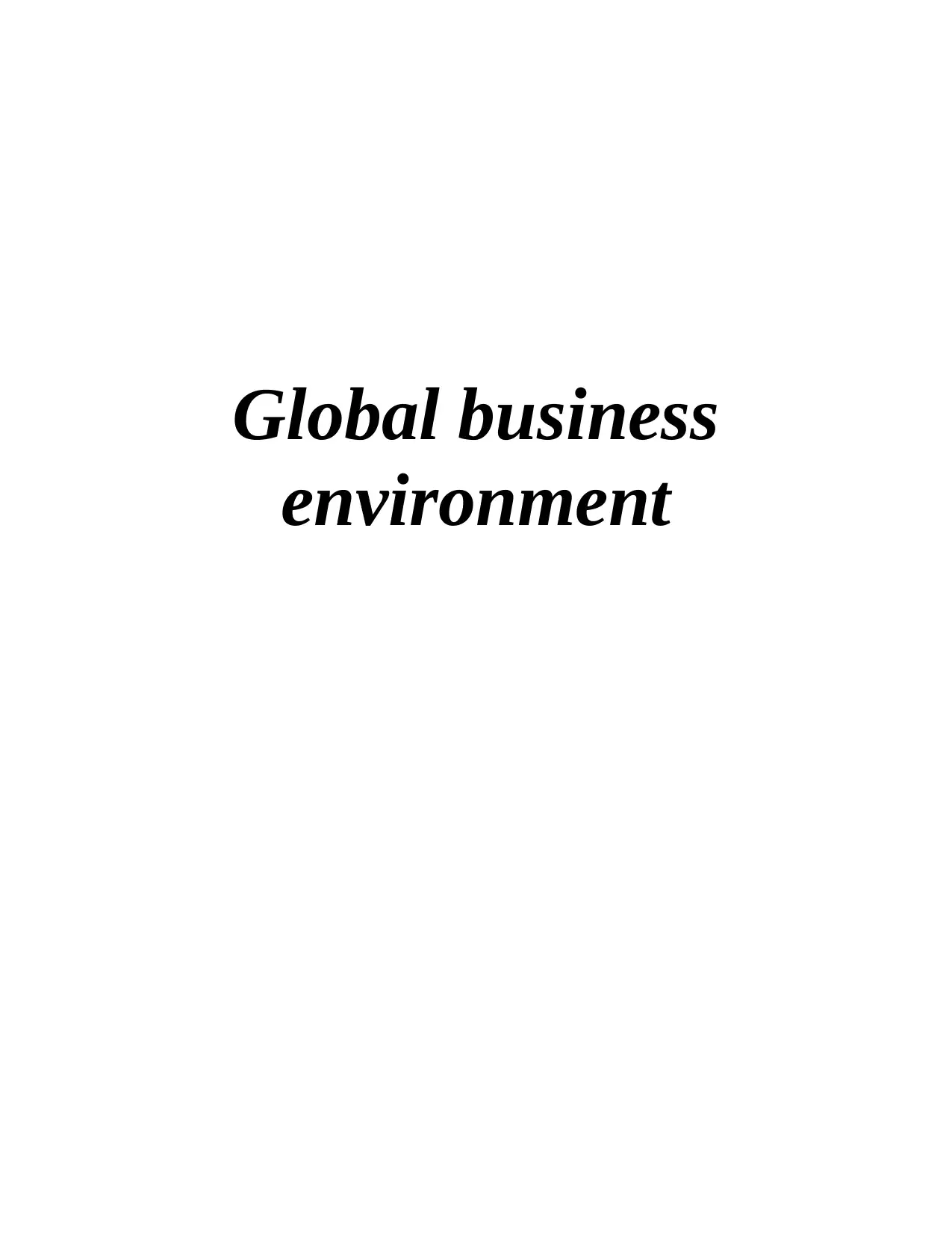
Global business
environment
environment
Secure Best Marks with AI Grader
Need help grading? Try our AI Grader for instant feedback on your assignments.
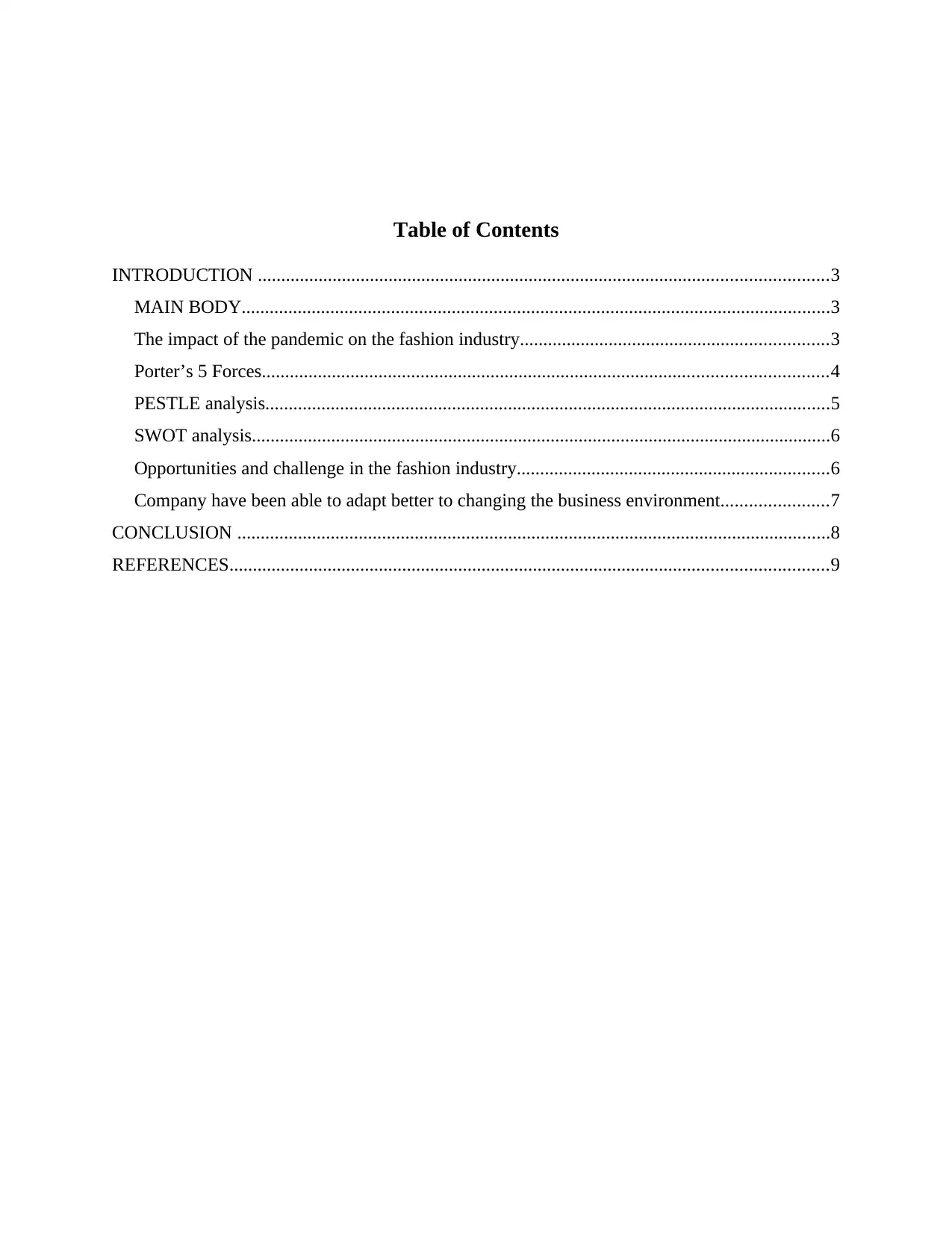
Table of Contents
INTRODUCTION ..........................................................................................................................3
MAIN BODY..............................................................................................................................3
The impact of the pandemic on the fashion industry..................................................................3
Porter’s 5 Forces.........................................................................................................................4
PESTLE analysis.........................................................................................................................5
SWOT analysis............................................................................................................................6
Opportunities and challenge in the fashion industry...................................................................6
Company have been able to adapt better to changing the business environment.......................7
CONCLUSION ...............................................................................................................................8
REFERENCES................................................................................................................................9
INTRODUCTION ..........................................................................................................................3
MAIN BODY..............................................................................................................................3
The impact of the pandemic on the fashion industry..................................................................3
Porter’s 5 Forces.........................................................................................................................4
PESTLE analysis.........................................................................................................................5
SWOT analysis............................................................................................................................6
Opportunities and challenge in the fashion industry...................................................................6
Company have been able to adapt better to changing the business environment.......................7
CONCLUSION ...............................................................................................................................8
REFERENCES................................................................................................................................9
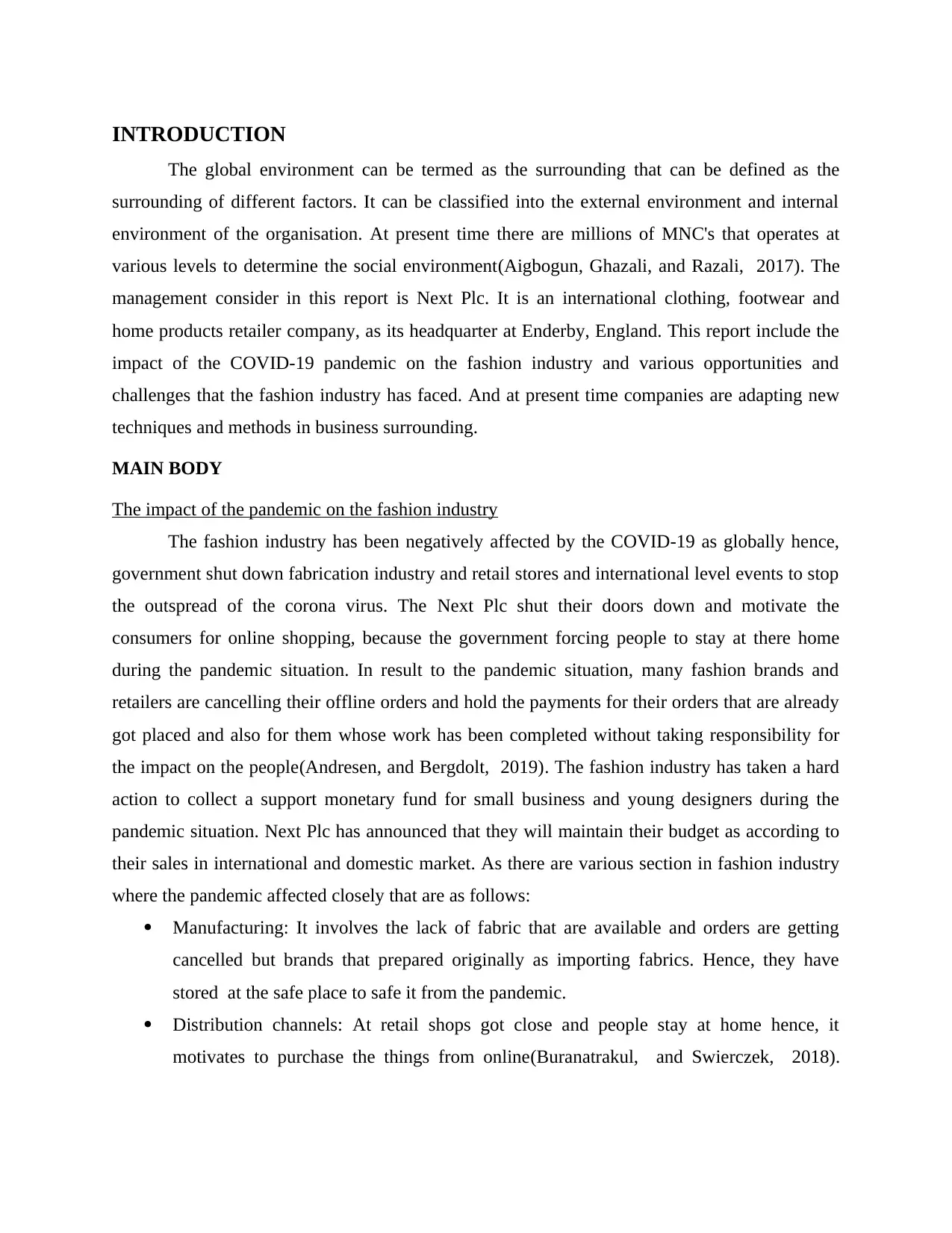
INTRODUCTION
The global environment can be termed as the surrounding that can be defined as the
surrounding of different factors. It can be classified into the external environment and internal
environment of the organisation. At present time there are millions of MNC's that operates at
various levels to determine the social environment(Aigbogun, Ghazali, and Razali, 2017). The
management consider in this report is Next Plc. It is an international clothing, footwear and
home products retailer company, as its headquarter at Enderby, England. This report include the
impact of the COVID-19 pandemic on the fashion industry and various opportunities and
challenges that the fashion industry has faced. And at present time companies are adapting new
techniques and methods in business surrounding.
MAIN BODY
The impact of the pandemic on the fashion industry
The fashion industry has been negatively affected by the COVID-19 as globally hence,
government shut down fabrication industry and retail stores and international level events to stop
the outspread of the corona virus. The Next Plc shut their doors down and motivate the
consumers for online shopping, because the government forcing people to stay at there home
during the pandemic situation. In result to the pandemic situation, many fashion brands and
retailers are cancelling their offline orders and hold the payments for their orders that are already
got placed and also for them whose work has been completed without taking responsibility for
the impact on the people(Andresen, and Bergdolt, 2019). The fashion industry has taken a hard
action to collect a support monetary fund for small business and young designers during the
pandemic situation. Next Plc has announced that they will maintain their budget as according to
their sales in international and domestic market. As there are various section in fashion industry
where the pandemic affected closely that are as follows:
Manufacturing: It involves the lack of fabric that are available and orders are getting
cancelled but brands that prepared originally as importing fabrics. Hence, they have
stored at the safe place to safe it from the pandemic.
Distribution channels: At retail shops got close and people stay at home hence, it
motivates to purchase the things from online(Buranatrakul, and Swierczek, 2018).
The global environment can be termed as the surrounding that can be defined as the
surrounding of different factors. It can be classified into the external environment and internal
environment of the organisation. At present time there are millions of MNC's that operates at
various levels to determine the social environment(Aigbogun, Ghazali, and Razali, 2017). The
management consider in this report is Next Plc. It is an international clothing, footwear and
home products retailer company, as its headquarter at Enderby, England. This report include the
impact of the COVID-19 pandemic on the fashion industry and various opportunities and
challenges that the fashion industry has faced. And at present time companies are adapting new
techniques and methods in business surrounding.
MAIN BODY
The impact of the pandemic on the fashion industry
The fashion industry has been negatively affected by the COVID-19 as globally hence,
government shut down fabrication industry and retail stores and international level events to stop
the outspread of the corona virus. The Next Plc shut their doors down and motivate the
consumers for online shopping, because the government forcing people to stay at there home
during the pandemic situation. In result to the pandemic situation, many fashion brands and
retailers are cancelling their offline orders and hold the payments for their orders that are already
got placed and also for them whose work has been completed without taking responsibility for
the impact on the people(Andresen, and Bergdolt, 2019). The fashion industry has taken a hard
action to collect a support monetary fund for small business and young designers during the
pandemic situation. Next Plc has announced that they will maintain their budget as according to
their sales in international and domestic market. As there are various section in fashion industry
where the pandemic affected closely that are as follows:
Manufacturing: It involves the lack of fabric that are available and orders are getting
cancelled but brands that prepared originally as importing fabrics. Hence, they have
stored at the safe place to safe it from the pandemic.
Distribution channels: At retail shops got close and people stay at home hence, it
motivates to purchase the things from online(Buranatrakul, and Swierczek, 2018).
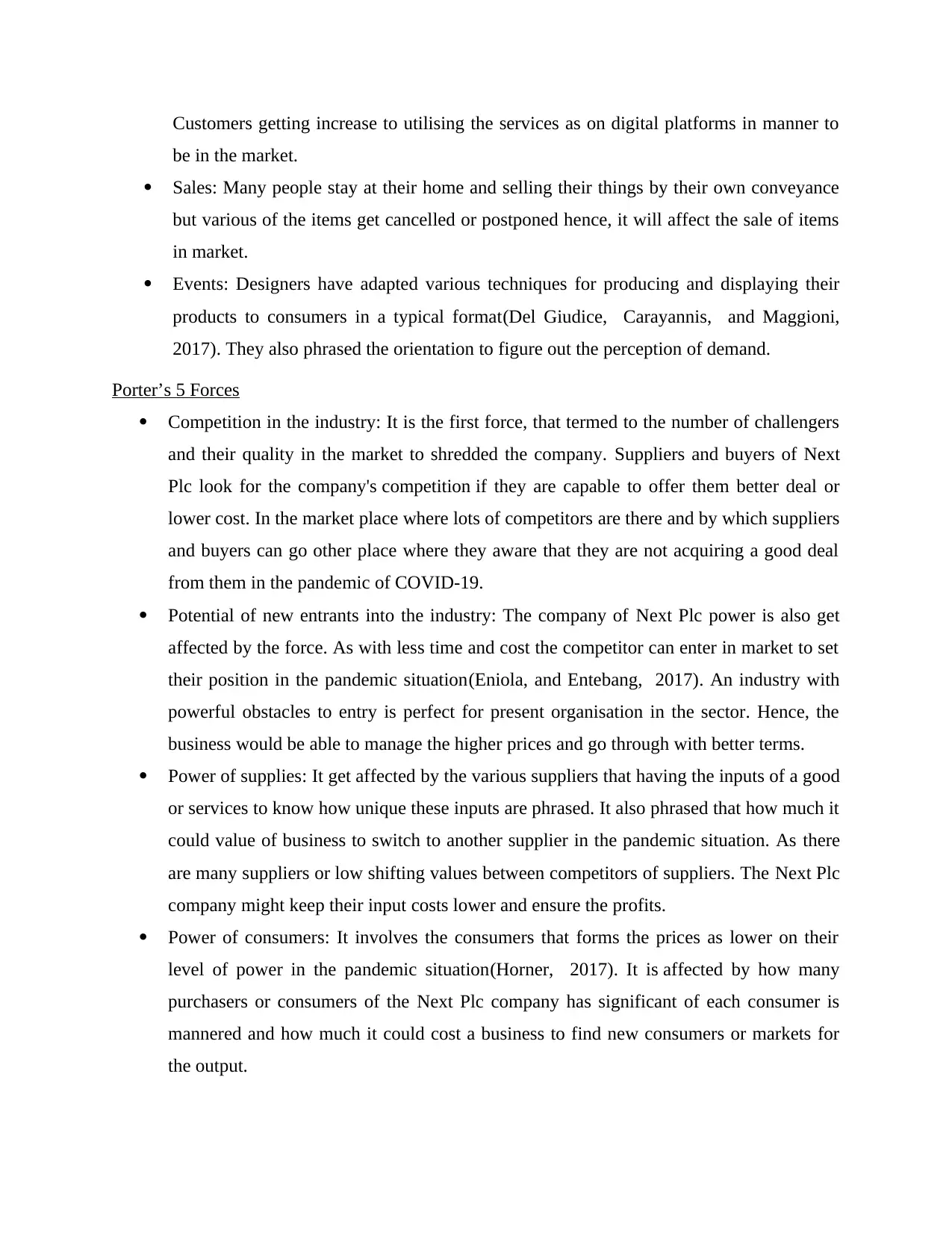
Customers getting increase to utilising the services as on digital platforms in manner to
be in the market.
Sales: Many people stay at their home and selling their things by their own conveyance
but various of the items get cancelled or postponed hence, it will affect the sale of items
in market.
Events: Designers have adapted various techniques for producing and displaying their
products to consumers in a typical format(Del Giudice, Carayannis, and Maggioni,
2017). They also phrased the orientation to figure out the perception of demand.
Porter’s 5 Forces
Competition in the industry: It is the first force, that termed to the number of challengers
and their quality in the market to shredded the company. Suppliers and buyers of Next
Plc look for the company's competition if they are capable to offer them better deal or
lower cost. In the market place where lots of competitors are there and by which suppliers
and buyers can go other place where they aware that they are not acquiring a good deal
from them in the pandemic of COVID-19.
Potential of new entrants into the industry: The company of Next Plc power is also get
affected by the force. As with less time and cost the competitor can enter in market to set
their position in the pandemic situation(Eniola, and Entebang, 2017). An industry with
powerful obstacles to entry is perfect for present organisation in the sector. Hence, the
business would be able to manage the higher prices and go through with better terms.
Power of supplies: It get affected by the various suppliers that having the inputs of a good
or services to know how unique these inputs are phrased. It also phrased that how much it
could value of business to switch to another supplier in the pandemic situation. As there
are many suppliers or low shifting values between competitors of suppliers. The Next Plc
company might keep their input costs lower and ensure the profits.
Power of consumers: It involves the consumers that forms the prices as lower on their
level of power in the pandemic situation(Horner, 2017). It is affected by how many
purchasers or consumers of the Next Plc company has significant of each consumer is
mannered and how much it could cost a business to find new consumers or markets for
the output.
be in the market.
Sales: Many people stay at their home and selling their things by their own conveyance
but various of the items get cancelled or postponed hence, it will affect the sale of items
in market.
Events: Designers have adapted various techniques for producing and displaying their
products to consumers in a typical format(Del Giudice, Carayannis, and Maggioni,
2017). They also phrased the orientation to figure out the perception of demand.
Porter’s 5 Forces
Competition in the industry: It is the first force, that termed to the number of challengers
and their quality in the market to shredded the company. Suppliers and buyers of Next
Plc look for the company's competition if they are capable to offer them better deal or
lower cost. In the market place where lots of competitors are there and by which suppliers
and buyers can go other place where they aware that they are not acquiring a good deal
from them in the pandemic of COVID-19.
Potential of new entrants into the industry: The company of Next Plc power is also get
affected by the force. As with less time and cost the competitor can enter in market to set
their position in the pandemic situation(Eniola, and Entebang, 2017). An industry with
powerful obstacles to entry is perfect for present organisation in the sector. Hence, the
business would be able to manage the higher prices and go through with better terms.
Power of supplies: It get affected by the various suppliers that having the inputs of a good
or services to know how unique these inputs are phrased. It also phrased that how much it
could value of business to switch to another supplier in the pandemic situation. As there
are many suppliers or low shifting values between competitors of suppliers. The Next Plc
company might keep their input costs lower and ensure the profits.
Power of consumers: It involves the consumers that forms the prices as lower on their
level of power in the pandemic situation(Horner, 2017). It is affected by how many
purchasers or consumers of the Next Plc company has significant of each consumer is
mannered and how much it could cost a business to find new consumers or markets for
the output.
Secure Best Marks with AI Grader
Need help grading? Try our AI Grader for instant feedback on your assignments.
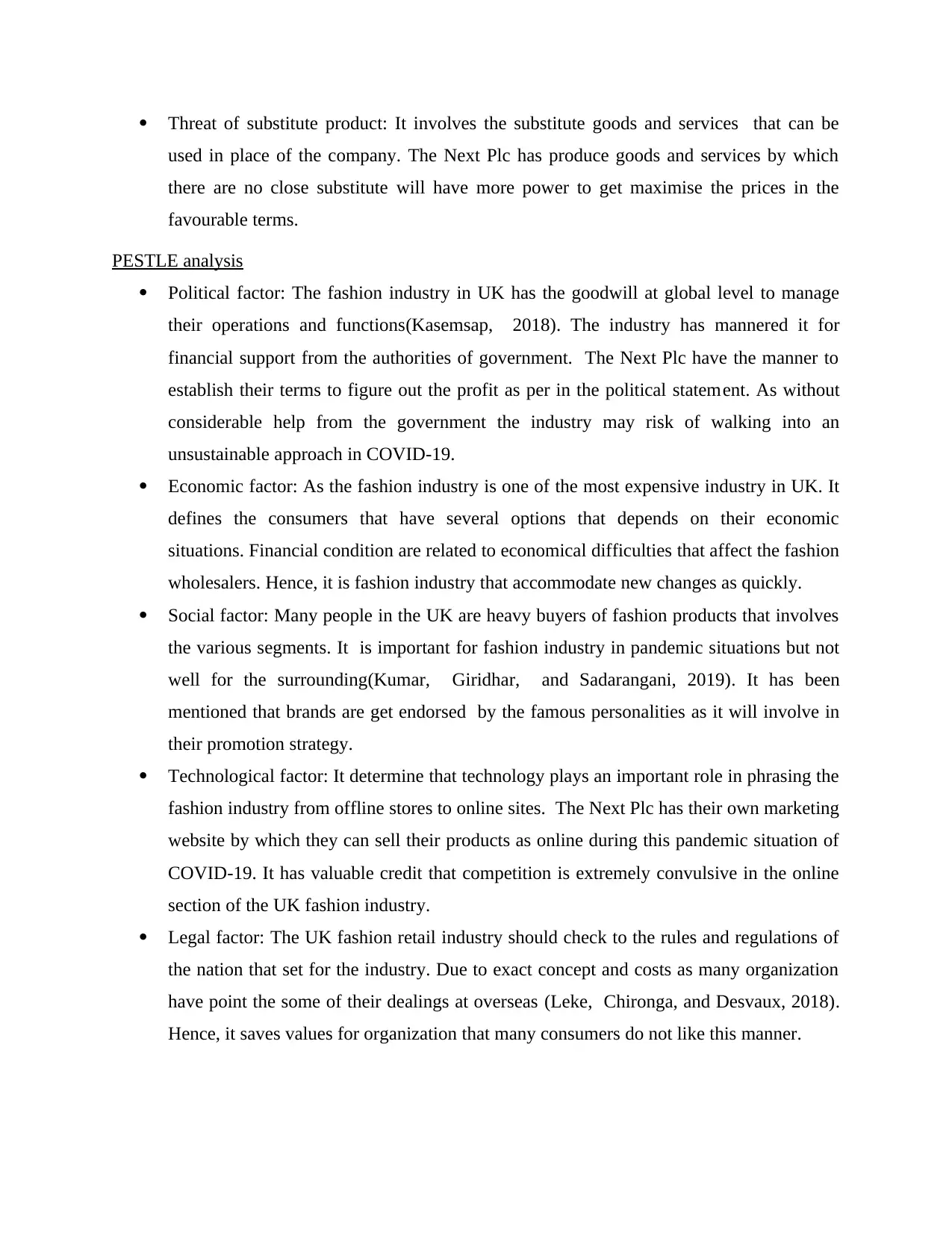
Threat of substitute product: It involves the substitute goods and services that can be
used in place of the company. The Next Plc has produce goods and services by which
there are no close substitute will have more power to get maximise the prices in the
favourable terms.
PESTLE analysis
Political factor: The fashion industry in UK has the goodwill at global level to manage
their operations and functions(Kasemsap, 2018). The industry has mannered it for
financial support from the authorities of government. The Next Plc have the manner to
establish their terms to figure out the profit as per in the political statement. As without
considerable help from the government the industry may risk of walking into an
unsustainable approach in COVID-19.
Economic factor: As the fashion industry is one of the most expensive industry in UK. It
defines the consumers that have several options that depends on their economic
situations. Financial condition are related to economical difficulties that affect the fashion
wholesalers. Hence, it is fashion industry that accommodate new changes as quickly.
Social factor: Many people in the UK are heavy buyers of fashion products that involves
the various segments. It is important for fashion industry in pandemic situations but not
well for the surrounding(Kumar, Giridhar, and Sadarangani, 2019). It has been
mentioned that brands are get endorsed by the famous personalities as it will involve in
their promotion strategy.
Technological factor: It determine that technology plays an important role in phrasing the
fashion industry from offline stores to online sites. The Next Plc has their own marketing
website by which they can sell their products as online during this pandemic situation of
COVID-19. It has valuable credit that competition is extremely convulsive in the online
section of the UK fashion industry.
Legal factor: The UK fashion retail industry should check to the rules and regulations of
the nation that set for the industry. Due to exact concept and costs as many organization
have point the some of their dealings at overseas (Leke, Chironga, and Desvaux, 2018).
Hence, it saves values for organization that many consumers do not like this manner.
used in place of the company. The Next Plc has produce goods and services by which
there are no close substitute will have more power to get maximise the prices in the
favourable terms.
PESTLE analysis
Political factor: The fashion industry in UK has the goodwill at global level to manage
their operations and functions(Kasemsap, 2018). The industry has mannered it for
financial support from the authorities of government. The Next Plc have the manner to
establish their terms to figure out the profit as per in the political statement. As without
considerable help from the government the industry may risk of walking into an
unsustainable approach in COVID-19.
Economic factor: As the fashion industry is one of the most expensive industry in UK. It
defines the consumers that have several options that depends on their economic
situations. Financial condition are related to economical difficulties that affect the fashion
wholesalers. Hence, it is fashion industry that accommodate new changes as quickly.
Social factor: Many people in the UK are heavy buyers of fashion products that involves
the various segments. It is important for fashion industry in pandemic situations but not
well for the surrounding(Kumar, Giridhar, and Sadarangani, 2019). It has been
mentioned that brands are get endorsed by the famous personalities as it will involve in
their promotion strategy.
Technological factor: It determine that technology plays an important role in phrasing the
fashion industry from offline stores to online sites. The Next Plc has their own marketing
website by which they can sell their products as online during this pandemic situation of
COVID-19. It has valuable credit that competition is extremely convulsive in the online
section of the UK fashion industry.
Legal factor: The UK fashion retail industry should check to the rules and regulations of
the nation that set for the industry. Due to exact concept and costs as many organization
have point the some of their dealings at overseas (Leke, Chironga, and Desvaux, 2018).
Hence, it saves values for organization that many consumers do not like this manner.
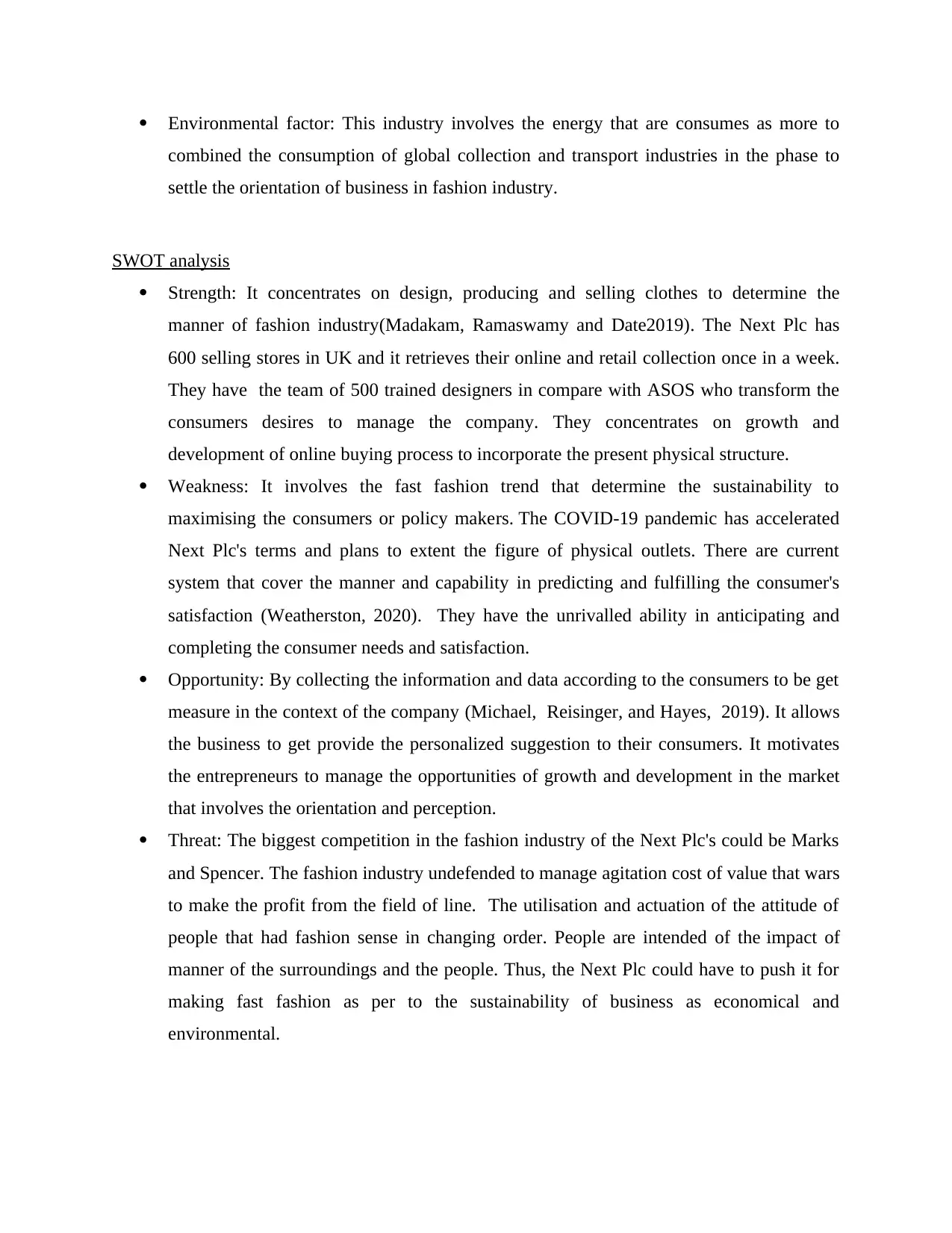
Environmental factor: This industry involves the energy that are consumes as more to
combined the consumption of global collection and transport industries in the phase to
settle the orientation of business in fashion industry.
SWOT analysis
Strength: It concentrates on design, producing and selling clothes to determine the
manner of fashion industry(Madakam, Ramaswamy and Date2019). The Next Plc has
600 selling stores in UK and it retrieves their online and retail collection once in a week.
They have the team of 500 trained designers in compare with ASOS who transform the
consumers desires to manage the company. They concentrates on growth and
development of online buying process to incorporate the present physical structure.
Weakness: It involves the fast fashion trend that determine the sustainability to
maximising the consumers or policy makers. The COVID-19 pandemic has accelerated
Next Plc's terms and plans to extent the figure of physical outlets. There are current
system that cover the manner and capability in predicting and fulfilling the consumer's
satisfaction (Weatherston, 2020). They have the unrivalled ability in anticipating and
completing the consumer needs and satisfaction.
Opportunity: By collecting the information and data according to the consumers to be get
measure in the context of the company (Michael, Reisinger, and Hayes, 2019). It allows
the business to get provide the personalized suggestion to their consumers. It motivates
the entrepreneurs to manage the opportunities of growth and development in the market
that involves the orientation and perception.
Threat: The biggest competition in the fashion industry of the Next Plc's could be Marks
and Spencer. The fashion industry undefended to manage agitation cost of value that wars
to make the profit from the field of line. The utilisation and actuation of the attitude of
people that had fashion sense in changing order. People are intended of the impact of
manner of the surroundings and the people. Thus, the Next Plc could have to push it for
making fast fashion as per to the sustainability of business as economical and
environmental.
combined the consumption of global collection and transport industries in the phase to
settle the orientation of business in fashion industry.
SWOT analysis
Strength: It concentrates on design, producing and selling clothes to determine the
manner of fashion industry(Madakam, Ramaswamy and Date2019). The Next Plc has
600 selling stores in UK and it retrieves their online and retail collection once in a week.
They have the team of 500 trained designers in compare with ASOS who transform the
consumers desires to manage the company. They concentrates on growth and
development of online buying process to incorporate the present physical structure.
Weakness: It involves the fast fashion trend that determine the sustainability to
maximising the consumers or policy makers. The COVID-19 pandemic has accelerated
Next Plc's terms and plans to extent the figure of physical outlets. There are current
system that cover the manner and capability in predicting and fulfilling the consumer's
satisfaction (Weatherston, 2020). They have the unrivalled ability in anticipating and
completing the consumer needs and satisfaction.
Opportunity: By collecting the information and data according to the consumers to be get
measure in the context of the company (Michael, Reisinger, and Hayes, 2019). It allows
the business to get provide the personalized suggestion to their consumers. It motivates
the entrepreneurs to manage the opportunities of growth and development in the market
that involves the orientation and perception.
Threat: The biggest competition in the fashion industry of the Next Plc's could be Marks
and Spencer. The fashion industry undefended to manage agitation cost of value that wars
to make the profit from the field of line. The utilisation and actuation of the attitude of
people that had fashion sense in changing order. People are intended of the impact of
manner of the surroundings and the people. Thus, the Next Plc could have to push it for
making fast fashion as per to the sustainability of business as economical and
environmental.
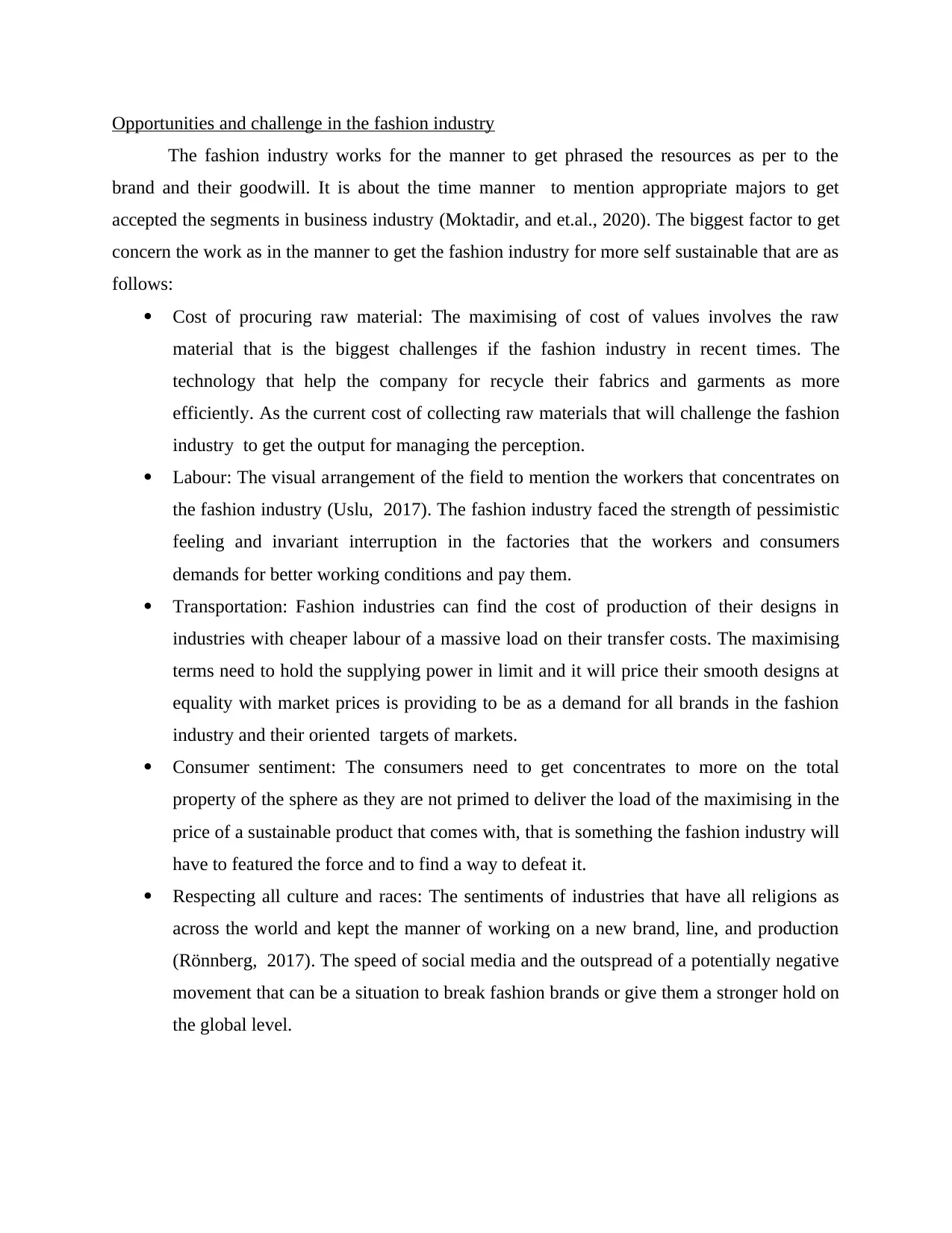
Opportunities and challenge in the fashion industry
The fashion industry works for the manner to get phrased the resources as per to the
brand and their goodwill. It is about the time manner to mention appropriate majors to get
accepted the segments in business industry (Moktadir, and et.al., 2020). The biggest factor to get
concern the work as in the manner to get the fashion industry for more self sustainable that are as
follows:
Cost of procuring raw material: The maximising of cost of values involves the raw
material that is the biggest challenges if the fashion industry in recent times. The
technology that help the company for recycle their fabrics and garments as more
efficiently. As the current cost of collecting raw materials that will challenge the fashion
industry to get the output for managing the perception.
Labour: The visual arrangement of the field to mention the workers that concentrates on
the fashion industry (Uslu, 2017). The fashion industry faced the strength of pessimistic
feeling and invariant interruption in the factories that the workers and consumers
demands for better working conditions and pay them.
Transportation: Fashion industries can find the cost of production of their designs in
industries with cheaper labour of a massive load on their transfer costs. The maximising
terms need to hold the supplying power in limit and it will price their smooth designs at
equality with market prices is providing to be as a demand for all brands in the fashion
industry and their oriented targets of markets.
Consumer sentiment: The consumers need to get concentrates to more on the total
property of the sphere as they are not primed to deliver the load of the maximising in the
price of a sustainable product that comes with, that is something the fashion industry will
have to featured the force and to find a way to defeat it.
Respecting all culture and races: The sentiments of industries that have all religions as
across the world and kept the manner of working on a new brand, line, and production
(Rönnberg, 2017). The speed of social media and the outspread of a potentially negative
movement that can be a situation to break fashion brands or give them a stronger hold on
the global level.
The fashion industry works for the manner to get phrased the resources as per to the
brand and their goodwill. It is about the time manner to mention appropriate majors to get
accepted the segments in business industry (Moktadir, and et.al., 2020). The biggest factor to get
concern the work as in the manner to get the fashion industry for more self sustainable that are as
follows:
Cost of procuring raw material: The maximising of cost of values involves the raw
material that is the biggest challenges if the fashion industry in recent times. The
technology that help the company for recycle their fabrics and garments as more
efficiently. As the current cost of collecting raw materials that will challenge the fashion
industry to get the output for managing the perception.
Labour: The visual arrangement of the field to mention the workers that concentrates on
the fashion industry (Uslu, 2017). The fashion industry faced the strength of pessimistic
feeling and invariant interruption in the factories that the workers and consumers
demands for better working conditions and pay them.
Transportation: Fashion industries can find the cost of production of their designs in
industries with cheaper labour of a massive load on their transfer costs. The maximising
terms need to hold the supplying power in limit and it will price their smooth designs at
equality with market prices is providing to be as a demand for all brands in the fashion
industry and their oriented targets of markets.
Consumer sentiment: The consumers need to get concentrates to more on the total
property of the sphere as they are not primed to deliver the load of the maximising in the
price of a sustainable product that comes with, that is something the fashion industry will
have to featured the force and to find a way to defeat it.
Respecting all culture and races: The sentiments of industries that have all religions as
across the world and kept the manner of working on a new brand, line, and production
(Rönnberg, 2017). The speed of social media and the outspread of a potentially negative
movement that can be a situation to break fashion brands or give them a stronger hold on
the global level.
Paraphrase This Document
Need a fresh take? Get an instant paraphrase of this document with our AI Paraphraser
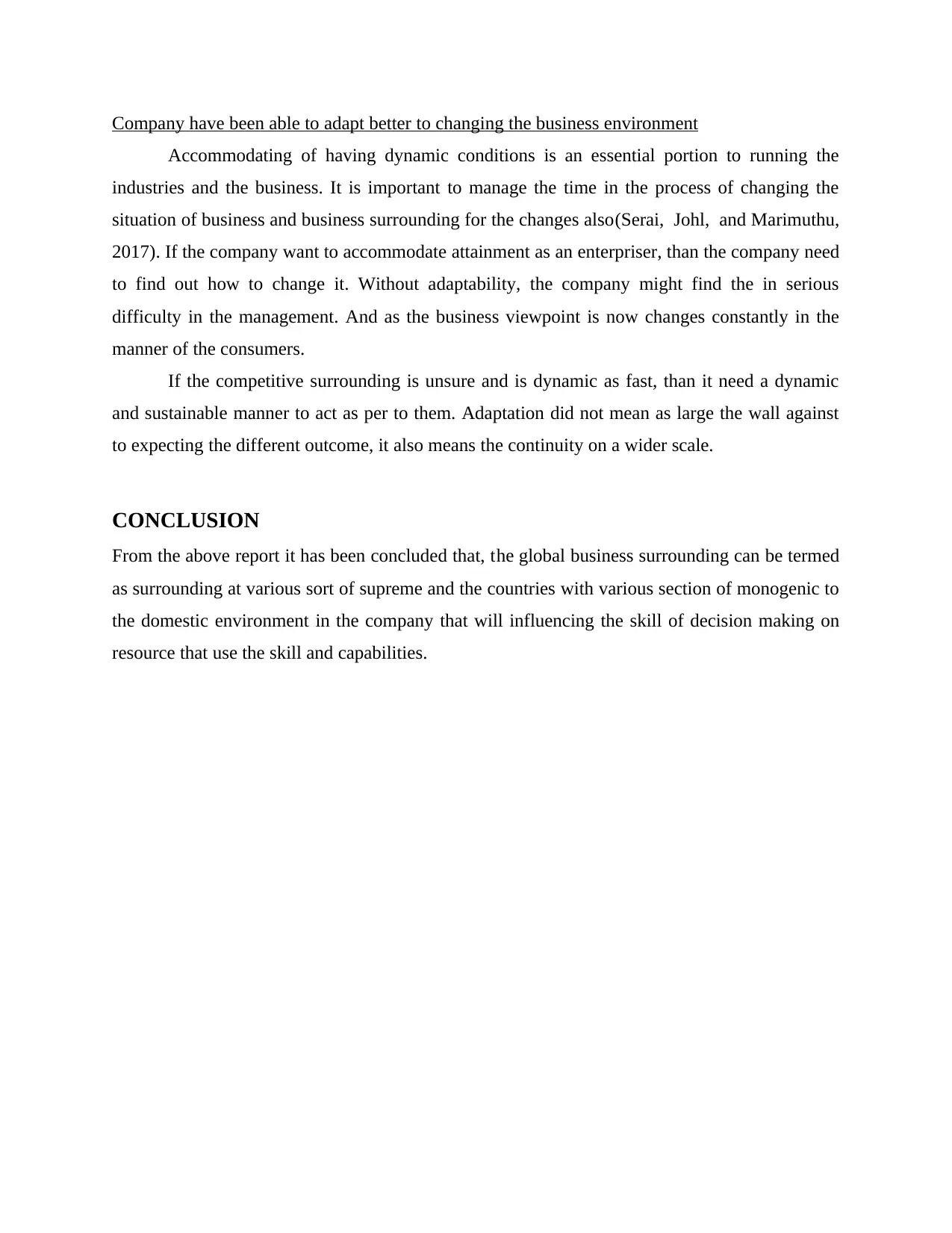
Company have been able to adapt better to changing the business environment
Accommodating of having dynamic conditions is an essential portion to running the
industries and the business. It is important to manage the time in the process of changing the
situation of business and business surrounding for the changes also(Serai, Johl, and Marimuthu,
2017). If the company want to accommodate attainment as an enterpriser, than the company need
to find out how to change it. Without adaptability, the company might find the in serious
difficulty in the management. And as the business viewpoint is now changes constantly in the
manner of the consumers.
If the competitive surrounding is unsure and is dynamic as fast, than it need a dynamic
and sustainable manner to act as per to them. Adaptation did not mean as large the wall against
to expecting the different outcome, it also means the continuity on a wider scale.
CONCLUSION
From the above report it has been concluded that, the global business surrounding can be termed
as surrounding at various sort of supreme and the countries with various section of monogenic to
the domestic environment in the company that will influencing the skill of decision making on
resource that use the skill and capabilities.
Accommodating of having dynamic conditions is an essential portion to running the
industries and the business. It is important to manage the time in the process of changing the
situation of business and business surrounding for the changes also(Serai, Johl, and Marimuthu,
2017). If the company want to accommodate attainment as an enterpriser, than the company need
to find out how to change it. Without adaptability, the company might find the in serious
difficulty in the management. And as the business viewpoint is now changes constantly in the
manner of the consumers.
If the competitive surrounding is unsure and is dynamic as fast, than it need a dynamic
and sustainable manner to act as per to them. Adaptation did not mean as large the wall against
to expecting the different outcome, it also means the continuity on a wider scale.
CONCLUSION
From the above report it has been concluded that, the global business surrounding can be termed
as surrounding at various sort of supreme and the countries with various section of monogenic to
the domestic environment in the company that will influencing the skill of decision making on
resource that use the skill and capabilities.
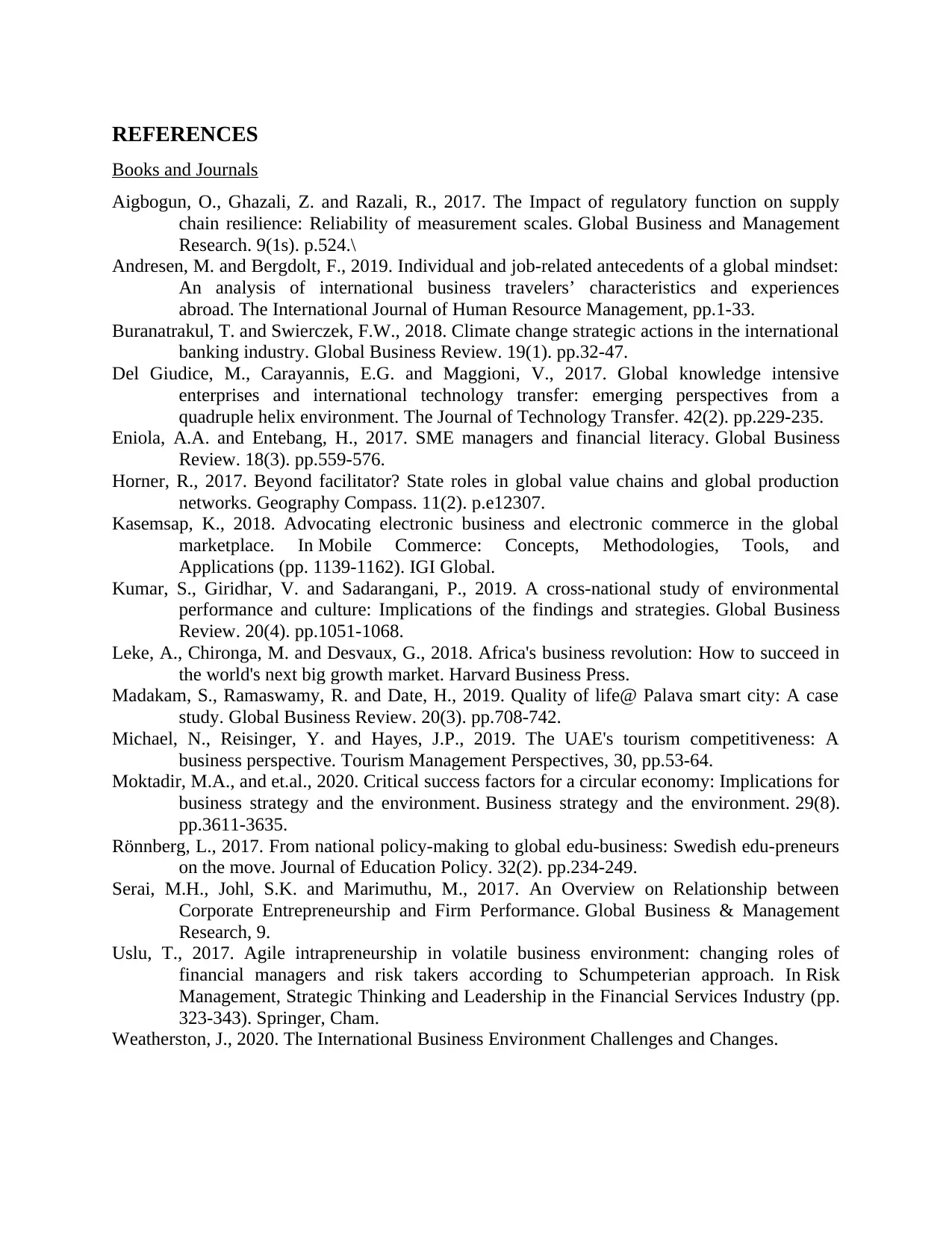
REFERENCES
Books and Journals
Aigbogun, O., Ghazali, Z. and Razali, R., 2017. The Impact of regulatory function on supply
chain resilience: Reliability of measurement scales. Global Business and Management
Research. 9(1s). p.524.\
Andresen, M. and Bergdolt, F., 2019. Individual and job-related antecedents of a global mindset:
An analysis of international business travelers’ characteristics and experiences
abroad. The International Journal of Human Resource Management, pp.1-33.
Buranatrakul, T. and Swierczek, F.W., 2018. Climate change strategic actions in the international
banking industry. Global Business Review. 19(1). pp.32-47.
Del Giudice, M., Carayannis, E.G. and Maggioni, V., 2017. Global knowledge intensive
enterprises and international technology transfer: emerging perspectives from a
quadruple helix environment. The Journal of Technology Transfer. 42(2). pp.229-235.
Eniola, A.A. and Entebang, H., 2017. SME managers and financial literacy. Global Business
Review. 18(3). pp.559-576.
Horner, R., 2017. Beyond facilitator? State roles in global value chains and global production
networks. Geography Compass. 11(2). p.e12307.
Kasemsap, K., 2018. Advocating electronic business and electronic commerce in the global
marketplace. In Mobile Commerce: Concepts, Methodologies, Tools, and
Applications (pp. 1139-1162). IGI Global.
Kumar, S., Giridhar, V. and Sadarangani, P., 2019. A cross-national study of environmental
performance and culture: Implications of the findings and strategies. Global Business
Review. 20(4). pp.1051-1068.
Leke, A., Chironga, M. and Desvaux, G., 2018. Africa's business revolution: How to succeed in
the world's next big growth market. Harvard Business Press.
Madakam, S., Ramaswamy, R. and Date, H., 2019. Quality of life@ Palava smart city: A case
study. Global Business Review. 20(3). pp.708-742.
Michael, N., Reisinger, Y. and Hayes, J.P., 2019. The UAE's tourism competitiveness: A
business perspective. Tourism Management Perspectives, 30, pp.53-64.
Moktadir, M.A., and et.al., 2020. Critical success factors for a circular economy: Implications for
business strategy and the environment. Business strategy and the environment. 29(8).
pp.3611-3635.
Rönnberg, L., 2017. From national policy-making to global edu-business: Swedish edu-preneurs
on the move. Journal of Education Policy. 32(2). pp.234-249.
Serai, M.H., Johl, S.K. and Marimuthu, M., 2017. An Overview on Relationship between
Corporate Entrepreneurship and Firm Performance. Global Business & Management
Research, 9.
Uslu, T., 2017. Agile intrapreneurship in volatile business environment: changing roles of
financial managers and risk takers according to Schumpeterian approach. In Risk
Management, Strategic Thinking and Leadership in the Financial Services Industry (pp.
323-343). Springer, Cham.
Weatherston, J., 2020. The International Business Environment Challenges and Changes.
Books and Journals
Aigbogun, O., Ghazali, Z. and Razali, R., 2017. The Impact of regulatory function on supply
chain resilience: Reliability of measurement scales. Global Business and Management
Research. 9(1s). p.524.\
Andresen, M. and Bergdolt, F., 2019. Individual and job-related antecedents of a global mindset:
An analysis of international business travelers’ characteristics and experiences
abroad. The International Journal of Human Resource Management, pp.1-33.
Buranatrakul, T. and Swierczek, F.W., 2018. Climate change strategic actions in the international
banking industry. Global Business Review. 19(1). pp.32-47.
Del Giudice, M., Carayannis, E.G. and Maggioni, V., 2017. Global knowledge intensive
enterprises and international technology transfer: emerging perspectives from a
quadruple helix environment. The Journal of Technology Transfer. 42(2). pp.229-235.
Eniola, A.A. and Entebang, H., 2017. SME managers and financial literacy. Global Business
Review. 18(3). pp.559-576.
Horner, R., 2017. Beyond facilitator? State roles in global value chains and global production
networks. Geography Compass. 11(2). p.e12307.
Kasemsap, K., 2018. Advocating electronic business and electronic commerce in the global
marketplace. In Mobile Commerce: Concepts, Methodologies, Tools, and
Applications (pp. 1139-1162). IGI Global.
Kumar, S., Giridhar, V. and Sadarangani, P., 2019. A cross-national study of environmental
performance and culture: Implications of the findings and strategies. Global Business
Review. 20(4). pp.1051-1068.
Leke, A., Chironga, M. and Desvaux, G., 2018. Africa's business revolution: How to succeed in
the world's next big growth market. Harvard Business Press.
Madakam, S., Ramaswamy, R. and Date, H., 2019. Quality of life@ Palava smart city: A case
study. Global Business Review. 20(3). pp.708-742.
Michael, N., Reisinger, Y. and Hayes, J.P., 2019. The UAE's tourism competitiveness: A
business perspective. Tourism Management Perspectives, 30, pp.53-64.
Moktadir, M.A., and et.al., 2020. Critical success factors for a circular economy: Implications for
business strategy and the environment. Business strategy and the environment. 29(8).
pp.3611-3635.
Rönnberg, L., 2017. From national policy-making to global edu-business: Swedish edu-preneurs
on the move. Journal of Education Policy. 32(2). pp.234-249.
Serai, M.H., Johl, S.K. and Marimuthu, M., 2017. An Overview on Relationship between
Corporate Entrepreneurship and Firm Performance. Global Business & Management
Research, 9.
Uslu, T., 2017. Agile intrapreneurship in volatile business environment: changing roles of
financial managers and risk takers according to Schumpeterian approach. In Risk
Management, Strategic Thinking and Leadership in the Financial Services Industry (pp.
323-343). Springer, Cham.
Weatherston, J., 2020. The International Business Environment Challenges and Changes.

Secure Best Marks with AI Grader
Need help grading? Try our AI Grader for instant feedback on your assignments.

1 out of 11
Related Documents
Your All-in-One AI-Powered Toolkit for Academic Success.
+13062052269
info@desklib.com
Available 24*7 on WhatsApp / Email
![[object Object]](/_next/static/media/star-bottom.7253800d.svg)
Unlock your academic potential
© 2024 | Zucol Services PVT LTD | All rights reserved.




